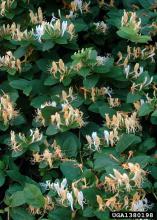Information Possibly Outdated
The information presented on this page was originally released on March 27, 2023. It may not be outdated, but please search our site for more current information. If you plan to quote or reference this information in a publication, please check with the Extension specialist or author before proceeding.
Find honeysuckle options for landscape additions
Weeds are often defined as being any plant out of place, but that definition never sat well with me. This simplistic definition underemphasizes the aggressiveness of plants that misbehave in the garden.
For example, I’ve never heard anyone having problems with hydrangeas popping up in the landscape unexpectedly. Nor have I heard someone call a hydrangea growing in the wrong spot a weed. Instead, I think of weeds as nuisance plants that have the capacity to outcompete desirable plants in the landscape or garden.
Unfortunately, we have introduced many plants in the U.S. that have become weedy problems. Kudzu, cogon grass, tallow tree, Chinese privet, and Chinese and Japanese wisteria are just a few examples.
But one plant that shows up on nearly every invasive species list is Lonicera japonica, commonly known as Japanese honeysuckle. This vining plant was first introduced in the U.S. in 1806 at Long Island, New York. Since its introduction, it has taken off in the eastern U.S.
It is one of the most fragrant flowers in the landscape, and it blooms prolifically. Birds love its red berries and help disperse the seeds. From there, the seeds quickly grow to overtake other plants in the forest. Several states have outlawed Japanese honeysuckle sales, indicating how destructive and invasive this plant has become.
If you find Japanese honeysuckle on your property, it would be prudent to remove it, but it requires some effort to get them out of the garden.
I had some growing along our fence line that I was able to remove over the course of a couple of years. I pruned the plants to the ground and dug out the shoots that reemerged over time. Herbicides can be effective, but the plants I was trying to remove were next to other plants that I did not want to risk damaging.
Once you remove Japanese honeysuckles, there are fantastic -- and in my opinion, even more beautiful -- noninvasive alternatives.
One of my favorite vining plants is the native coral honeysuckle, Lonicera sempervirens. These vines have trumpet-shaped, red-orange flowers that emerge in early spring, which is late March or early April for central Mississippi. Hummingbirds love them.
Their leaves are often a powdery, bluish-green, while others are glossy green. These vines are usually evergreen in mild winters. In the fall, they often develop small, red berries that birds love.
Native coral honeysuckle also tolerates a wide range of soil types and sun exposure. Ours flower and grow very well at the Mississippi State University Truck Crops Branch Experiment Station in Crystal Springs despite the heavy shade of oak trees. These plants are also easy to grow with little to no disease and insect problems.
In full sun, flowering is especially heavy.
Coral honeysuckle is very versatile in the landscape. It can be grown on structures such as arbors or along fences. This can create eye-catching hardscape-softscape combinations in areas needing extra height. And unlike some vining plants that get out of hand, you can prune coral honeysuckle to keep it a manageable size.
Perhaps the only downside is their lack of the iconic honeysuckle fragrance.
If you miss the fragrance of Japanese honeysuckle, a good alternative is the woodbine honeysuckle, Lonicera periclymenum. This selection is native to Europe but does not appear on any invasive species list. Several cultivars are available. Scentsation and Graham Thomas have flowers that look very similar to Japanese honeysuckle and offer good fragrance.
If you have a spot needing a vine, give these alternatives a try.
[EDITOR’S NOTE: Dr. Shaun Broderick is a Mississippi State University Extension Service ornamental horticulturist, Mississippi Agricultural and Forestry Experiment Station researcher and Southern Gardening guest columnist.]



